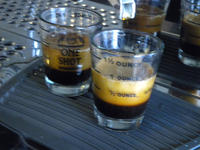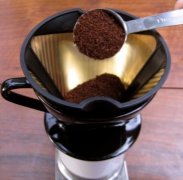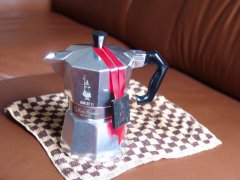Espresso Al's Rule
Al Critzer's understanding of Espresso extraction has now become the most common Espresso concept in Europe and America.

The translation reads as follows:
Start with the result of getting a perfect cup of Espresso at 30cc/ 30sec. These two values depend on the beans, of course, and differences in baking methods, baking degrees, and recipe proportions naturally lead to changes in the reference point.
The amount of extraction is inversely proportional to the extraction time:
When the amount of extraction is higher, the coffee powder must be in contact with hot water for a shorter time (to avoid over-extraction).
Conversely, when the amount of extraction is reduced, the contact time between coffee powder and water should be increased (to avoid under-extraction).
Al formula: For every 5cc increase in extraction volume, the extraction time is subtracted by 1sec. Otherwise, add 1sec.
For example, when the extraction amount is increased to 45cc, 30-(45-30) divided by 5=27, the extraction time is reduced to 27sec.
When the extraction amount is 60cc, the extraction time becomes 24sec.
This formula, within reasonable limits of 0.75-2.5oz Espresso, quickly and correctly hunts for sweet spots, effectively captures desirable ingredients, and maintains a balance between over-extraction and under-extraction. The main method of control is to adjust the grinding thickness.
In addition, Al Critzer also explained the definition of Ristretto:
Ristretto is a drink that is very different from normal espresso.
If the grinding is unchanged, use the normal espresso flow rate and end the extraction early, for example, the original 30sec/ 30cc flow rate, only 25cc, this is a cup of insufficient extraction results, because it has not reached the sweet spot (Sweet Spot).
The so-called ristretto means restricted, and the customary practice is 25cc/ 30-35sec.
All sensory sensations, whether good or bad, are accentuated: what the eye sees, what the nose smells, what the tongue tastes.
Ristretto is characterized by a mouse tail that is extremely thin, plus a darker brown crema, so it is also adjusted by grinding.
Important Notice :
前街咖啡 FrontStreet Coffee has moved to new addredd:
FrontStreet Coffee Address: 315,Donghua East Road,GuangZhou
Tel:020 38364473
- Prev

The ratio of coffee to water
(figure Source: google) Standard brewing ratio (Standard Brewing Ratio) number of coffee cups the amount of coffee used by COFFEE TO BE USED WATER TO BE USED Cups of Coffee by weight BY WEIGHT BY MEASURE ounces Ounces grams Grams teaspoons Tea tablespoons Table cups Cups coffee liquid (ounces) Cups
- Next

Making Espresso with octagonal mocha pot
There are three most commonly used methods of making coffee, one is siphon, the second is high-pressure steam extraction, and the third is drip filtration. What I'm teaching you today is a relatively simple method of brewing coffee in a mocha pot, that is, the method of high-pressure steam extraction mentioned above. This method first appeared in Italy, and large commercial coffee machines generally use this method to make coffee. This kind of hair is made.
Related
- Beginners will see the "Coffee pull flower" guide!
- What is the difference between ice blog purified milk and ordinary milk coffee?
- Why is the Philippines the largest producer of crops in Liberia?
- For coffee extraction, should the fine powder be retained?
- How does extracted espresso fill pressed powder? How much strength does it take to press the powder?
- How to make jasmine cold extract coffee? Is the jasmine + latte good?
- Will this little toy really make the coffee taste better? How does Lily Drip affect coffee extraction?
- Will the action of slapping the filter cup also affect coffee extraction?
- What's the difference between powder-to-water ratio and powder-to-liquid ratio?
- What is the Ethiopian local species? What does it have to do with Heirloom native species?

